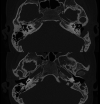Cholesteatoma Masquerading as Recurrent Langerhans Cell Histiocytosis
- PMID: 36718041
- PMCID: PMC9984908
- DOI: 10.5152/iao.2023.22716
Cholesteatoma Masquerading as Recurrent Langerhans Cell Histiocytosis
Abstract
Langerhans cell histiocytosis is a rare condition affecting the temporal bone in up to 60% of cases. Symptoms are non-specific and the differential diagnosis includes infection, benign lesions such as cholesteatoma, and malignant lesions of the skull base. Here, we report the case of a 14-yearold child referred with chronic ear discharge, and background of multifocal Langerhans cell histiocytosis 9 years prior. Recurrence of Langerhans cell histiocytosis was initially suspected and systemic treatment was considered. Further imaging workup and surgical exploration of the mastoid showed a secondary acquired cholesteatoma arising from a dehiscent posterior ear canal wall. Surgical removal of the cholesteatoma was performed with a canal wall down procedure. We review the presentation and management of temporal bone Langerhans cell histiocytosis. We recommend that cholesteatoma should be considered in case of recurrence of otological symptoms in patients with a background of Langerhans cell histiocytosis.
Figures




References
-
- Thacker NH, Abla O. Pediatric Langerhans cell histiocytosis: state of the science and future directions. Clin Adv Hematol Oncol. 2019;17(2):122 131. - PubMed
Publication types
MeSH terms
LinkOut - more resources
Full Text Sources
Medical
